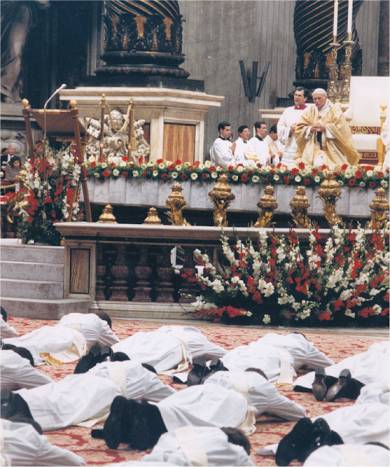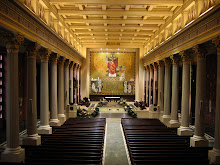Rich Leonardi posted earlier today on an upcoming event in the Archdiocese, but also contains information regarding the developments in the formation of priests and cites the John Jay study. (That's a mouthful!)
I want to focus on the third of those links: the changes in the formation programs in seminaries and the results that have come from these changes.
In my experience (ordained 2004), the formation that is largely available at seminaries today is a very personal experience. By this, I do not mean subjective experience; but rather the seminary takes an individual look at each candidate and assesses both the strengths that he possesses and the weaknesses that he must overcome while in the context of a seminary community. Formation is not a 'one size fits all' program.
The result of this is that the men in formation come to a deeper awareness of their own gifts and limitations (hopefully!), and how they would respond in certain situations as well. As a result of this 'growth process,' (I know, cliche alert!) some guys do go through counseling, some guys receive extra training in dealing with individuals, homiletics, singing, whatever he may need.
The goal of the formation process is to produce a priest who understands his abilities, the implications of living a celibate life in the midst of a hostile world, and that he will truly represent Christ out in the world. That's a lot to take into account.
From my understanding, the formation programs in the 1950's (again, born in 1976, so this is by reputation) were more about fitting into an assigned role, completing academic programs, and, to an extent, looking the part. There was not a strong spiritual direction program. 'Formation' was nearly non-existant. You were expected to meet these criteria, and if you stepped out of line, see ya later!
The result of this, from a decidedly non-psychological perspective, was that a fair number of men ordained in that time frame repressed or hid their true selves, or did not deal with emotional or psychological problems at the time, or did not have the freedom to grow as a human person before taking on the role of 'priest;' that so much of the normal psycho-social development was repressed and came out later in very dramatic ways. So much so, that I feel quite comfortable saying that this contributed to the sexual abuse crisis of the last 7 years. But, for sure, it was not the only cause, and it may not even be the leading cause; but it certainly contributed, of that I am sure.
In my experience, again, we have learned from these lessons and, today, are much more selective in who we admit to the seminary, and there are greater criteria as far as continuing in the seminary as well.
However, my concern is that this is not universal. There is a certain order that is very prominent today that, again in my limited experience, has reverted to a 1950s formation program, where the men have to fit a very specific model of priesthood, and any expression of individualism is squashed. A diocesan priest, from another diocese, was telling me that he explored this particular religious community before entering wtih the diocese. Because he was having back problems at the time, he politely declined going on a canoe outing, or something similar. He stated that because he was unwilling to go on this little outing, he was shunned the rest of the weekend and eventually 'it was discerned that he didn't have a calling with this order.'
Certainly, one unique story is not enough to raise concerns, but I've had enough experience from a formation prespective with both candidates who have experience with this order and priests from the order that I hold the entire group at an arms length, even though I know that they do some very good things. Their secrecy causes me suspicion, and it does not prove to be fruitful in formation, as guys are formed to hide what's going on inside instead of addressing it with formation and spiritual directors.
Finally, a word on the 'two models of priesthood' that are so popular in church circles these days. There is a desire to create a tension between what is called the 'cultic' model of the priesthood versus the 'servant leader' model of the priesthood. The dichotomy sets up in the way that, usually, the priests that subscribe to the 'cultic' model of the priesthood want to be served by their parishioners, they represent Christ in the community and hence have a dignity that others should recognize. They are only interested in the liturgy, and music and transcendence. In contrast, the 'servant-leader' priest is one who leads a community by being collaborative, listens, is among the people, etc. These priests are all about the immanent aspects of the faith, the nitty-gritty stuff.
In the popular parlance of today, the servant leader is extolled as the perfect priest and these newer, younger 'cultic' priests are out of touch with the needs of the people.
In my experience, this is a false dichotomy. The priests that are actually more likely to hold concretely fast to a day off, less likely to get out of bed to make a midnight run to the hospital, are actually the 'servant leaders.'
The model that younger priests and seminarians of today subscribe to is more aptly described as 'Priest as a Living Icon of Christ.' In this idea, the priest wears clerics regularly so that he can be identified as Christ living among his people. He desire to celebrate the liturgy with the respect and dignity it deserves, so that it nourishes the faithful to be able to live out their calling in the world. He wants to give his life for his people as Christ gave His life for us. He will listen to his people, but understands that he is responsible for their souls and is therefore willing to make difficult decisions, unpopular decisions, because he knows it is ultimately better for their souls and will lead them to Eternal Life. These are the priests that also willingly give of their day off to go to the hospital, to have a funeral, to visit the grade school. Because they identify with Christ, but also recognize that they are human, they recognize that their redemption is based on helping others come to Eternal Life. They take the good aspects of this 'cultic' vs 'servant leader' models and combine them in a real and approachable package.
I am convinced that this is the model of priesthood that will help the Church to flourish into the future. This is the model that our seminarians and young priests have been formed and encouraged into, and such, it presents great hope for our future.
Subscribe to:
Post Comments (Atom)










2 comments:
For an example of fifties thinking read what the Baltimore Catechism #3 has to say about who should be a priest. It specifically excludes boys who think God has called them somehow and suggests that boys who enjoy serving as altar boys and are academically advanced are the ones who are called. This is just ...odd... Jane M
I'm wondering about the order you referenced...and I know you won't name it, but I have my suspicions about which one it is. (If it's the one I'm thinking of, their model has destroyed men who would have made wonderful priests and who are now shattered versions of their former selves.) But it's just as possible to be something different. In any case, if we are measuring by the fruit, as you're noting, we need to take a balanced approach...the very approach dictated by the combination of faith and reason together.
Post a Comment